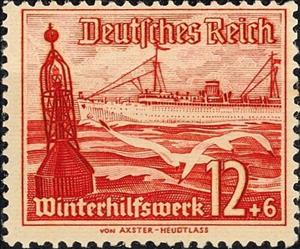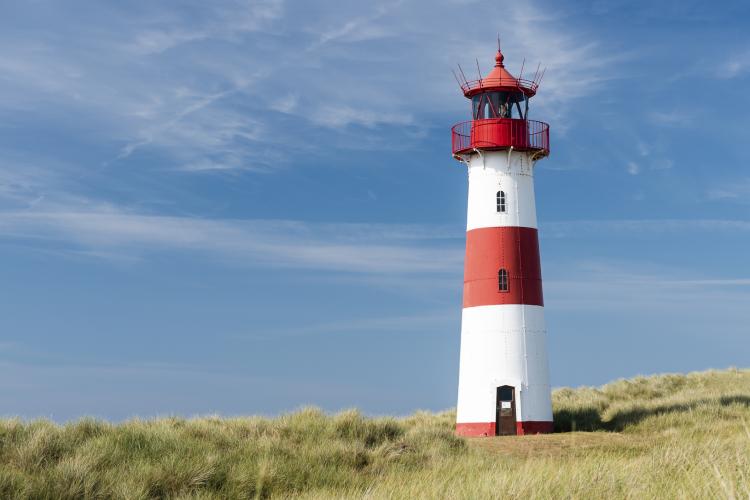Stamp: Steamer 'Tannenberg' of East Prussia naval service (Austria 1938)
Steamer 'Tannenberg' of East Prussia naval service (Austria 1938)
04 April (Austria ) within release German Realm stamps used in Austria 1938-1945 goes into circulation Stamp Steamer 'Tannenberg' of East Prussia naval service face value 12+6 German reichspfennig
| Stamp Steamer 'Tannenberg' of East Prussia naval service in catalogues | |
|---|---|
| Michel: | Mi: DR-AT 656 |
| ANK: | ANK: DR-AT 656 |
Stamp is horizontal format.
Mi: DR 656 Used stamp only. Stamp or cut off must bear readable cancellation from Austria during the occupation period or before the expiry date.Also in the issue German Realm stamps used in Austria 1938-1945:
- Stamp - Castle Rheinstein face value 1;
- Stamp - Marienburg face value 3;
- Stamp - Paul von Hindenburg (1847-1934), 2nd President face value 4;
- Stamp - Paul von Hindenburg (1847-1934), 2nd President face value 5;
- Stamp - Paul von Hindenburg (1847-1934), 2nd President face value 12;
- Stamp - Paul von Hindenburg (1847-1934), 2nd President face value 15;
- Stamp - Paul von Hindenburg (1847-1934), 2nd President face value 25;
- Stamp - Paul von Hindenburg (1847-1934), 2nd President face value 50;
- Stamp - Paul von Hindenburg (1847-1934), 2nd President face value 3;
- Stamp - Paul von Hindenburg (1847-1934), 2nd President face value 4;
- Stamp - Paul von Hindenburg (1847-1934), 2nd President face value 6;
- Stamp - Paul von Hindenburg (1847-1934), 2nd President face value 10;
- Stamp - Paul von Hindenburg (1847-1934), 2nd President face value 12;
- Stamp - Paul von Hindenburg (1847-1934), 2nd President face value 15;
- Stamp - Paul von Hindenburg (1847-1934), 2nd President face value 20;
- Stamp - Paul von Hindenburg (1847-1934), 2nd President face value 30;
- Stamp - Paul von Hindenburg (1847-1934), 2nd President face value 40;
- Stamp - Paul von Hindenburg (1847-1934), 2nd President face value 50;
- Stamp - Paul von Hindenburg (1847-1934), 2nd President face value 60;
- Stamp - Paul von Hindenburg (1847-1934), 2nd President face value 80;
- Stamp - Paul von Hindenburg (1847-1934), 2nd President face value 100;
- Stamp - Paul von Hindenburg (1847-1934), 2nd President face value 1;
- Stamp - Paul von Hindenburg (1847-1934), 2nd President face value 3;
- Stamp - Paul von Hindenburg (1847-1934), 2nd President face value 4;
- Stamp - Paul von Hindenburg (1847-1934), 2nd President face value 5;
- Stamp - Paul von Hindenburg (1847-1934), 2nd President face value 6;
- Stamp - Paul von Hindenburg (1847-1934), 2nd President face value 8;
- Stamp - Paul von Hindenburg (1847-1934), 2nd President face value 12;
- Stamp - Paul von Hindenburg (1847-1934), 2nd President face value 15;
- Stamp - Paul von Hindenburg (1847-1934), 2nd President face value 20;
- Stamp - Paul von Hindenburg (1847-1934), 2nd President face value 25;
- Stamp - Paul von Hindenburg (1847-1934), 2nd President face value 25;
- Stamp - Paul von Hindenburg (1847-1934), 2nd President face value 30;
- Stamp - Paul von Hindenburg (1847-1934), 2nd President face value 40;
- Stamp - Paul von Hindenburg (1847-1934), 2nd President face value 10;
- Stamp - Speyer Cathedral face value 5;
- Stamp - View onto Old-Cologne face value 2;
- Stamp - View onto Old-Cologne face value 2;
- Stamp - 4-mast-barc 'Padua' face value 8+4;
- Stamp - Adolf Hitler (1889-1945), Chancellor face value 6+19;
- Souvenir Sheet - Adolf Hitler (1889-1945), Chancellor face value 4*(6+19);
- Stamp - Adolf Hitler (1889-1945), Chancellor face value 6+19;
- Souvenir Sheet - Adolf Hitler (1889-1945), Chancellor face value 4*(6+19);
- Stamp - Adolf Hitler (1889-1945), Chancellor face value 6+19;
- Souvenir Sheet - Adolf Hitler (1889-1945), Chancellor face value 4*(6+19);
- Stamp - Adolf Hitler (1889-1945), Chancellor face value 6+19;
- Souvenir Sheet - Adolf Hitler (1889-1945), Chancellor face value 1;
- Stamp - Count Zeppelin and airship LZ-127 Graf Zeppelin face value 3;
- Stamp - Count Zeppelin and airship LZ-127 Graf Zeppelin face value 3;
- Stamp - Ferry 'Schwerin' of the line Warnemünde-Gedser face value 15+10;
- Stamp - Fishing Boats on the Curonian Spit face value 5+3;
- Stamp - Galloper face value 42+108;
- Souvenir Sheet - Galloper face value 42+108;
- Stamp - Golden Eagle and globe face value 5;
- Stamp - Golden Eagle and globe face value 10;
- Stamp - Golden Eagle and globe face value 15;
- Stamp - Golden Eagle and globe face value 20;
- Stamp - Golden Eagle and globe face value 5;
- Stamp - Golden Eagle and globe face value 10;
- Stamp - Golden Eagle and globe face value 15;
- Stamp - Golden Eagle and globe face value 20;
- Stamp - Golden Eagle and globe face value 25;
- Stamp - Golden Eagle and globe face value 40;
- Stamp - Golden Eagle and globe face value 50;
- Stamp - Golden Eagle and globe face value 80;
- Stamp - Golden Eagle and globe face value 100;
- Stamp - Golden Eagle and globe face value 100;
- Stamp - Hitler Culture Fund. 5th Anniv of Hitler's Leadership. face value 6+4;
- Stamp - Hitler Culture Fund. 5th Anniv of Hitler's Leadership. face value 12+8;
- Stamp - KdF ship " Wilhelm Gustloff ' in front of Madeira face value 6+4;
- Stamp - Lifeboat 'Bremen' of the German Society for Sea Rescue face value 3+2;
- Stamp - Lightship 'Elbe 1' face value 4+3;
- Stamp - Liner 'Europe' of the North German Lloyd face value 40+35;
- Stamp - Liner 'Europe' of the North German Lloyd face value 40+35;
- Stamp - Liner 'Hamburg' of the Hapag face value 25+15;
- Stamp - Otto Lilienthal and Lilienthal biplane glider face value 2;
- Stamp - Otto Lilienthal and Lilienthal biplane glider face value 2;
- Stamp - Paul von Hindenburg (1847-1934), 2nd President face value 50;
- Stamp - Paul von Hindenburg (1847-1934), 2nd President face value 60;
- Stamp - Paul von Hindenburg (1847-1934), 2nd President face value 80;
- Stamp - Paul von Hindenburg (1847-1934), 2nd President face value 100;
- Stamp - Shield holder with badge of the Air-raid Protection Associat face value 3;
- Stamp - Shield holder with badge of the Air-raid Protection Associat face value 6;
- Stamp - Shield holder with badge of the Air-raid Protection Associat face value 12;
- Stamp - Steamer 'Tannenberg' of East Prussia naval service face value 12+6;
Stamp Steamer 'Tannenberg' of East Prussia naval service it reflects the thematic directions:
Birds (Aves), a subgroup of Reptiles, are the last living examples of Dinosaurs. They are a group of endothermic vertebrates, characterised by feathers, toothless beaked jaws, the laying of hard-shelled eggs, a high metabolic rate, a four-chambered heart, and a strong yet lightweight skeleton. Birds live worldwide and range in size from the 5 cm (2 in) bee hummingbird to the 2.75 m (9 ft) ostrich. They rank as the class of tetrapods with the most living species, at approximately ten thousand, with more than half of these being passerines, sometimes known as perching birds. Birds are the closest living relatives of crocodilians.
A lighthouse is a tower, building, or other type of structure designed to emit light from a system of lamps and lenses, and to serve as a navigational aid for maritime pilots at sea or on inland waterways. Lighthouses mark dangerous coastlines, hazardous shoals, reefs, and safe entries to harbors, and can assist in aerial navigation. Once widely used, the number of operational lighthouses has declined due to the expense of maintenance and use of electronic navigational systems.
A ship is a large watercraft that travels the world's oceans and other sufficiently deep waterways, carrying passengers or goods, or in support of specialized missions, such as defense, research and fishing. Historically, a "ship" was a sailing vessel with at least three square-rigged masts and a full bowsprit. Ships are generally distinguished from boats, based on size, shape and load capacity.
These clams live buried in the sediment on tidal flats. While they are common in muddy areas, their name "arenaria" means sandy and they prefer a combination of sandy and muddy areas. They are well known as a food item on the coast of New England in the Western Atlantic Ocean; however, the range extends much farther north to Canada and south to the Southern states. They are also found in the Eastern Atlantic Ocean, for example in the UK, as well as in the North Sea's Wadden Sea (where they are the dominant large clam).




